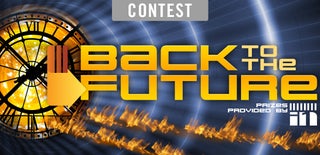Introduction: Apple Branded Back to the Future Hover Board
MARTY! We got to go back, TO THE FUTURE!
But, what would this hoverboard really look like today?
Step 1: Materials
1. Glue gun/sticks - already had
2. Scissors - already had
3. 3 sheets of 1/4 inch Foam Core (1 extra) - $3 A.C Moore
4. Small plastic silver appetizers dishes - $4 Amazing Savings
5. Spray adhesive - $5 Home Depot
6. Utility knife with some extra blades - already had
7. Sheet metal - $5-$8 Home Depot
8. Non-glare styrene sheets (2-3) - $4.50 each, Home Depot
9. Metallic silver spray paint - $7 G
10. Apple Logo stickers - already had
10. *Optional* 2 Running Lights - $2 each Radio Shack
Step 2: Size It
I looked up skateboard dimensions and used the ones that I felt would feel the best for my size.
You can also use a classic BTTF hover board template now for sizing.
I used http://www.angelfire.com/pa5/jdoud2/bttf_hoverboard_vector.pdf for my design. After a lot of playing around with the sizes, I printed it out one copy (on multiple sheets). A large one in black and white- this one is for the outline of the actual board, so make it as big as you want the board.
Step 3: Combine the Foam Core
You can save some money here by adding a little extra work: Cut the foam core pieces in half, so you need two sheets instead of three. Attach three pieces of foam core to each other with the spray adhesive. Don't worry about the lines matching up exactly, what's important is that everything lines up enough for you to cut out the hoverboard.
Step 4: Cut It Out!
Cut the design you printed out, and tape it tighter so it lines up properly. Lay it on the now three quarter inch thick foam core you created and trace. Cut out the hoverboard, from the foam core.
DO NOT throw away the paper design, you will need it later.
Step 5: Make Some Holes
Cut holes in the middle of the foam core to make windows like mine has. Make sure to leave a border so the foam core and styrene sheet has something to be glued to.
Step 6: Create the Tail
There are 2 methods for this. The proper way, and the easy way. I took the easy way to measure how big I wanted the tail/fin to be. I suggest looking at your colored design and seeing where you want the fin to be.
Easy way: just cut a straight 90 degree cut across the fin line. Angle the piece as you want and fill with hot glue. To help cover some of the cracks left in-between the board and the hot glue I used some spackle.
Proper way: cut at an angle and sand edges so it lines up perfectly to whatever angle you desire. Add a little glue and boom, fits perfect.
Step 7: AW SHEET!
Take the sheet metal and trace your paper design onto the metal sheet. Remember you can always cut it bigger and trim it down after. To cut it I used a pair of scissors. I highly suggest gloves and jeans, you will scratch yourself at the very least if you do not wear these.
Line up where your windows are from the foam core on the sheet metal and cut it out. My method: use a utility knife to cut a small square, fit the scissors into the square and cut out the windows from there. Take it slow on the corners.
Step 8: The Windows
Measure out how big your styrene sheets should be and mark it. Cut out the sheet using a utility knife. You only have one shot at scoring it. How to: score the sheet then run the knife through it one or two more times before snapping it with your hands.
Glues the windows on top of the holes you made on the top and bottom of the foam core. Make sure there is enough room in-between the styrene sheet and the foam core for the sheet metal to be glued.
Step 9: Attach the Sheet Metal
Attach the top or bottom piece of sheet metal of the foam core with hot glue (put hot glue on foam core). Then cut a long strip of sheet metal and wrap it around the side of the board and cut off the excess so it is level with the board. glue the strip onto the side and then glue the other piece of sheet metal onto the top or bottom.
Step 10: Bottom Pieces
So close, yet so far.
First take the dishes, flip them over, and paint the rims.
Next take a template for these bottom pieces from google and print them out to the size you find best for your overboard. I had to print 3-4 times to get what I wanted. The outline does not have to be crystal clear. Mine I cropped from a bigger picture and was EXTREMELY pixalated, what matters is that you can cut it out crisp.
Trace the design for the middle curvy piece onto a piece that is 3 thick. I didn't use the piece that touches the dish for a more sleek look. if you want to use that more traditional design: Trace the design for the pieces that touch the dish onto foam core that is one layer thick.
I lined the side of the center piece with paper using the method I used with the hoverboard rim.
Paint the center piece silver.
Step 11: How to Attach Bottom Pieces
Before gluing on the dishes there is an optional step. Using the utility knife slowly and VERY carefully cut out a rectangle for the lights to fit into. NOTE: the dishes are very fragile, and will crack. I ran out of dishes, and had to use my least cracked one.
Glue the dishes near the front and back of the overboard like the classic BTFF hoverboard. Then, glue the squiggly piece onto the bottom of the hoverboard nice and centered.
Step 12: Brand It!
Place the apple logo sticker on the top part of the tail and one on the middle of the squiggle piece on the bottom.
Step 13: All Done!
Now it is time for you to go hovering!
Congrats on your build,
Here's a video on the working lights if you put them in!
Attachments

Participated in the
Back to the Future Contest

Participated in the
Halloween Props Contest 2015














